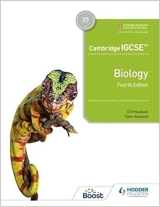Chapter 37. Sensitivity
Page 319
1. a (i) Roots respond to the directional ‘pull’ of gravity by growing towards it.
(ii) Shoots respond to direction of light by growing towards it and to the direction of gravity by growing away from it.
b (i) Positively phototropic; shoots.
(ii) Positively geotropic; roots.
(iii) Negatively geotropic; shoots.
2. a The whole plant does not move. Only the shoots grow towards light.
b The root does not bend. Tropisms are growth movements. The root tip changes its direction of growth and grows downwards.
3. A clinostat is the only way that a unidirectional stimulus can be applied equally to all sides of a root or shoot and thus act as a control in tropism experiments.
4. The outline of the stem will be something like this.
The first curvature is now in a non-growing part of the stem
so the next curvature will take place at the growing point. |
 |
5. As soon as the root and shoot emerge they will be exposed to the one sided stimulus of gravity. The root will respond by growing downwards and the shoot will respond by growing upwards.
6. The result would depend on the relative ‘strengths’ of the two stimuli. If the light stimulus were the stronger the shoot would grow downwards (the positive phototropism overwhelming the negative geotropism). Since the stimulus of one-sided gravity cannot easily be altered the result would depend entirely on the light intensity. At low light intensity the shoot would grow upwards, (negative geotropism more effective than weak phototropism).
Page 320
1. a Light suppresses the extension of the shoot but makes the leaves turn green.
b In positive phototropism, the unidirectional stimulus of light could suppress the growth of the shoot on the illuminated side. This would have the effect of causing the shoot to grow towards the light source.
2. You could set up the apparatus as in Fig. 37.6 but remove the tip of one of the radicles and leave the other as a control. The radicle without its tip should not show a change of direction of growth.
The snag is that by removing the radicle tip you could also remove the source of dividing cells
so that growth stops altogether. You could try reducing the size of the cut region, till you get to less than 1mm.
Page 323
1. a The wasps appear to be attracted to the smell of food, particularly fruit and sugary substances.
b In this case the wasps seem attracted to the light and try to reach it by flying to the windows.
2. It may be that the water makes the choice chamber cooler on that side and this slows the woodlice down. Although we cannot detect it, there may be a volatile chemical in the silica gel which makes the woodlice move more rapidly.
3. The control would be to make conditions in both chambers the same by excluding both water and silica gel. If illumination is even or the experiment conducted in darkness, there should be no overall change in the distribution of the woodlice.
4. Set up the choice chamber in such a way that one half is in darkness. Alternatively, illuminate the chamber from one side in case the direction of light has an effect.
5. Most animals which move freely, travel in the direction of their long axis. So it is the front end of the animal which first encounters any stimulus: smell, light, sound etc. The front end of the animal is therefore where the sensory organs will be most effective. This arrangement will have evolved over millions of years, becoming more obvious as the sense organs became more sophisticated. |
Downloads
Download the answers in PDF format below
Section 1, Chapters 1-5
Section 2, Chapters 6-9
Section 3, Chapters 10-12
Section 3, Chapters 13-17
Section 3, Chapters 18-20
Section 4, Chapters 21-24
Section 5, Chapters 25-27
Section 5, Chapters 28-29
Section 6, Chapters 30-34
Section 6, Chapters 35-37
Section 7, Chapters 38-39
Section 8, Chapters 40-41
|

